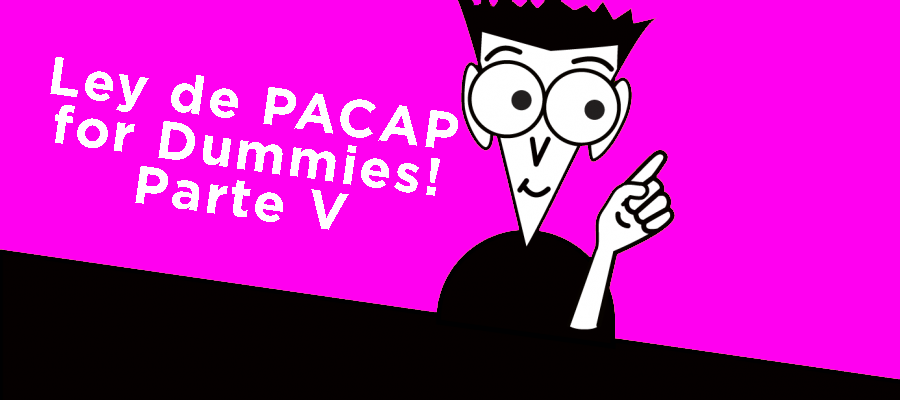Entender la Ley PACAP. Parte V: Legislación española
We already have a basis to understand what we will discuss in this article.
Let's start by describing the structure of the law.
We are talking about a section that makes up 90% of the document, which are the general provisions, and in the last 8 pages we have the rest of the provisions.
The law consists of 133 articles distributed in seven titles, five additional provisions, five transitional provisions, a derogatory provision, and seven final provisions.
Before giving an overview of the first title, the law starts with an apartado de Jefatura del Estado as a preface divided into five blocks.
I: It explains that the Public Administration acts with full submission to the Law and to the Right as stated in Article 103 of the Constitution. It is mentioned that a Commission for the Reform of Public Administrations was formed in 2013, which drafted a report based on the conviction that a competitive economy requires efficient, transparent, and agile public administrations. Traditionally, the defects attributed to public administrations are the appearance of duplications and inefficiencies, and some procedures were too complicated, which ultimately generated insecurity.
II: Article 103 specifies that public administrations must be governed by the principle of effectiveness and legality to guarantee the rights of citizens and companies, which must be exercised in conditions of equality throughout the territory, independently of the administration, as contemplated in Article 105 of the Constitution: the law will regulate the hearing of citizens directly or through recognized organizations and associations by law. Article 149 of the Constitution contemplates that the state regulates the administrative procedure, without prejudice to the specialities derived from the organization of Autonomous Communities. The administrative procedure is understood as the set of formalities and updates carried out to issue an administrative act or express the will of the administration. The common administrative procedure managed by the state does not prevent Autonomous Communities from issuing their own norms, as long as they do not conflict with state norms.
III: A little history. This point refers to previous laws that have formed part of the administrative procedure. They do not cite all of them, but list them here.
Law of Azcarate of 1889. It bears the name of its main promoter, Gumersindo de Azcárate, also known as the main promoter of the usury repression law of 1908. The law of 1889 is the first law that gave shape to the administrative procedure in Spain. It was published in the Gazette (pre-BOE) on July 24. https://www.boe.es/buscar/pdf/1889/BOE-A-1889-4763-consolidado.pdf
Law of administrative procedure of July 17, 1958. This is the first specialized law on administrative procedure: https://www.boe.es/datos/pdfs/BOE//1958/171/A01275-01287.pdf
With the new Constitution of 1978, it is specified for the first time that the administration is subject to the law and the right as a democratic popular expression, as we mentioned in the previous article.
In 1992, Law 30/1992 of November 26: Juridical Regime of Public Administrations and Common Administrative Procedure. A significant evolution in the functioning of public administrations. It is aware of the impact of new technologies on public administration. https://www.boe.es/boe/dias/1992/11/27/pdfs/A40300-40319.pdf
Law 4/1999 of January 13: Modification of Law 30/1992. It reformulates several aspects such as the administrative silence, system of review of administrative acts, or the regime of patrimonial responsibility. https://www.boe.es/boe/dias/1999/01/14/pdfs/A01739-01755.pdf
In 2007, Law 11/2007 of June 22: Electronic Access Law to Public Services, which gives legal nature to electronic access to public services, and obliges public administrations to equip themselves with the necessary means and systems to enable that right. https://www.boe.es/buscar/pdf/2007/BOE-A-2007-12352-consolidado.pdf
It is considered that in the current situation, electronic processing is not an option, but it must be the habitual operation of public administrations. An administration without paper-based functioning, entirely electronic, improves the principles of effectiveness and efficiency, saves costs, reinforces the guarantees of interested parties, and facilitates compliance with transparency obligations. However, there was a problem of overlapping and dispersal of normative regulations that contradicted each other, such as Law 17/2009 of November 23, on free access to services and its exercise; Law 2/2011 of March 4, on Sustainable Economy; and Law 19/2013 of December 9, on Guarantee of the Unity of the Market.
The purpose of this new law is to clarify and systematize the administrative procedure, making it more agile and electronic.
IV: Since 1992, we have been advancing in the improvement of normative production (Better regulation and Smart regulation). International reports consider that intelligent regulation is a quality legal framework. It dynamizes economic activity, simplifies processes, and reduces administrative burdens. It is necessary to have a new regularization that ends the existing normative dispersion, reinforces citizen participation, legal security, and review of the order. It is necessary in a decentralized state like ours that has three levels of territorial administration: municipalities, provinces, and autonomous communities.
V: Summary of the document in a very general way. The most important thing is that it establishes that only through Law can establish additional or different procedures contemplated in this norm: deadlines, forms of initiation and termination, and others. It also mentions the validity of Annex 2, Disposition 29 of Law 14/2000 of December 29, on Fiscal, Administrative, and Social Measures, which establishes the procedures that are exempt from the positive administrative silence. In the next link comes the list of procedures: http://noticias.juridicas.com/base_datos/Admin/l14-2000.t5.html#da29
It summarizes what each of the five titles of the general provisions consists of.
Regulates specialities in administrative law, extending it to unions or entities without legal personality and independent or autonomous patrimonies. This title focuses on one of the most important novelties of the law: the separation between identification/signature and the simplification of means to prove one or the other. Only the first will be required, and the second will be required when it is necessary to prove the interested party's will. Only qualified or recognized electronic signature systems, as provided for in Regulation (EU) 910/2014 of 23 July https://eur-lex.europa.eu/legal-content/ES/TXT/?uri=celex:32014R0910
It is structured into two chapters:
On general rules of conduct. It obliges all Public Administrations to have an electronic general register, or, failing that, to adhere to the AGE register. These registers will be assisted by the network of offices for registration, which will allow those who request it to submit their requests on paper, which will be converted into electronic format. Also, administrations will be obliged to have a unique electronic file of documents from completed processes, to ensure the conservation, authenticity, and integrity of the document. This electronic system must be compatible with the established systems and networks in current legislation, and it will be responsible for its custody and transfer. It must also be compatible with the continuity of the Historical National Archive (Law 16/1985) https://www.boe.es/buscar/act.php?id=BOE-A-1985-12534
It establishes the terms and deadlines for computation, amplification, or urgent processing. Deadlines by hours and declaration of Saturdays as non-working days, equating with the computation of deadlines in the judicial sphere.
It is structured into three chapters and focuses on the regulation of administrative acts, their effectiveness, and their rules of nullity and annulment, maintaining the general rules established by Law 30/1992 http://noticias.juridicas.com/base_datos/Admin/l30-1992.html
It is structured into seven chapters. Its novelty is that it has integrated as specialities of the common administrative procedure the special procedures on punitive power and patrimonial responsibility of Law 30/1992, which previously regulated separate titles, thus achieving simplification. Additionally, it incorporates the mandatory use of electronic means in the phases of initiation, ordering, instruction, and finalization. It also incorporates the maximum deadline for the resolution of the common administrative procedure (30 days).
It deals with the review of acts in administrative review. As a novelty, it includes that the administrative body can suspend the deadline for resolution if there is a pending judicial ruling. The law has already abolished prior claims in civil and labor matters, due to their little practical utility.
The legislative initiative and normative power of Public Administrations recovers the principles of making constitutional rights effective. As a novelty, it includes mechanisms to increase citizen participation in the process of elaborating norms, gathering information about the problems to be solved. It bets on improving the normative planning ex ante (a priori), and for this, it will publish an Annual Normative Plan to collect proposals with the rank of law or regulation that will be submitted for approval the following year, although it also values the ex post (a posteriori) analysis and periodic evaluation of the application of existing norms.
In relation to the rest of the provisions of the document, it is worth noting the adherence of Autonomous Communities and Local Entities to the registers and systems established by the AGE. Principle of efficiency recognized in Law 2/2012, of April 27: https://www.boe.es/boe/dias/2012/04/30/pdfs/BOE-A-2012-5730.pdf




